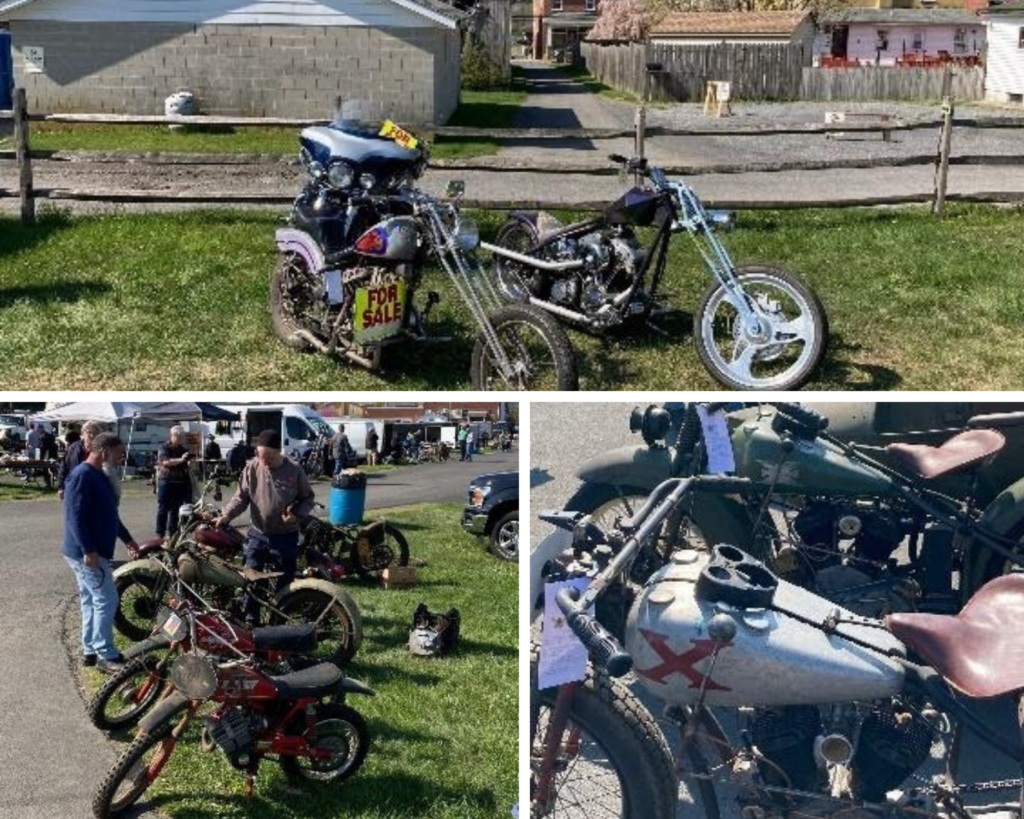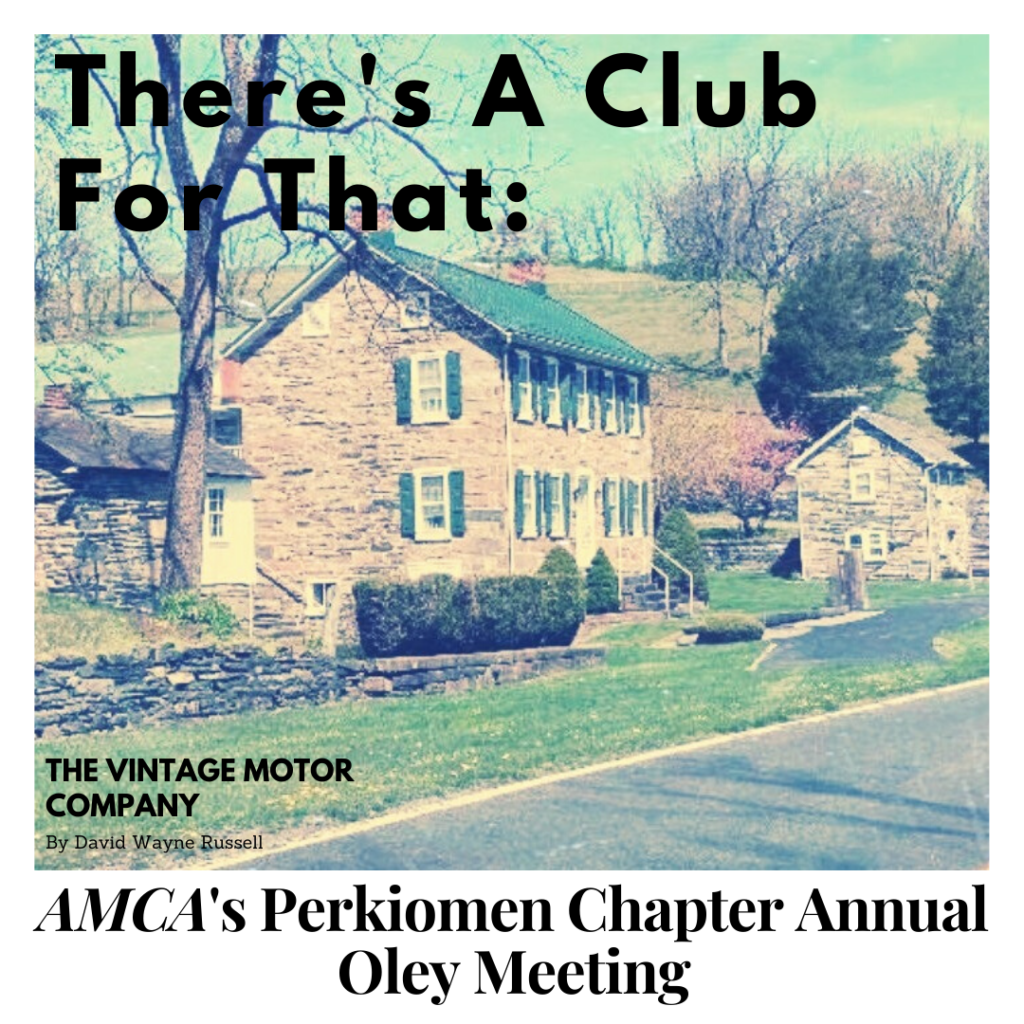No products in the cart.
American Journalism, Motorcycle Culture
There’s a Club for that:
In the atmosphere of American vintage motorcycle culture, there are two principal national organizations. Servicing historic racing enthusiasts is, of course, the American Historical Racing Motorcycle Association (AHRMA). For those who enjoy preserving, restoring, exhibiting, and riding vintage bikes, the Antique Motorcycle Club of America (AMCA) is the largest single such organization. (While AMCA may be the largest–though, at 12,000 or so members, it’s not that large–it isn’t necessarily well known. My interactions with vintage bike enthusiasts lead me to believe that many of them simply aren’t aware of the AMCA…or possibly have heard of it, but dismiss it out-of-hand as just a club for ‘old Harley guys.’ We’ll get to that!)
The AMCA is nonetheless the first (to my knowledge) and foremost American organization devoted to the preservation and enjoyment of all vintage motorcycles. It supports regional meetings and rides organized by their local chapters, and maintains an objective criteria for the evaluation (judging) of antique motorcycles. It’s a first-class operation that should be considered by every motorcycle enthusiast—no matter what machines they ride or enjoy. In the next few pages I’ll hopefully create a picture of the AMCA by means of an accompanying virtual tour of the 2021 Perkiomen chapter meet in Oley, Pennsylvania…so, here we go!
Up front, let me state that from nearly any direction you arrive from, to reach the small town of Oley, the ride will almost certainly be beautiful. The old villages of southeastern Pennsylvania, settled by German immigrants in the early 1700s, contain surviving period stone houses and original hardwood barns that continue to be studied by historians and sociologists. Our personal trek, from Harrisburg, in the west, travelling east on the interstate and then taking up country roads from Lenhartsville, past Kutztown and then Fleetwood, is—on a sunny spring morning—certainly a hard-to-beat country drive. The destination town of Oley itself dates from approximately 1700, and is a marvelously preserved small American town.
The Perkiomen Chapter of the AMCA, founded in 1971, has held their annual meet on the Oley Fairgrounds since 1984. There is no admittance fee, and no charge for parking in the adjacent school lot. There’ll be likely no traffic issues, either, as you roll down Oley’s main street. Once parked and entering the fairgrounds—and before you get that next cup of coffee or homemade snack from the nice folks in the food buildings—you’ll encounter one of the key elements of an AMCA meet: the show field. Normally, the morning of the last meet day is Judging/Show Day. We arrived on Saturday morning, so the judging field was filling up; following are some show bike highlights, followed by a look at the vendor area.
This above creative display greeted us on arrival. It features a 1972 Penton (KTM-built, but heavily inspired by John Penton’s guidance) 100cc Berkshire model, set up for the International Six-day Trials (ISDT; the “Olympics of Motorcycling”) competition. The rider/manikin is wearing period clothing which looks to be actual ISDT attire. The motorcycle is original, and we can assume being judged in the original (un-restored) category. This level of presentation isn’t the norm for AMCA judging, but certainly helps tell the story of an old motorcycle. And, it’s refreshing; simply thrusting something old into public view doesn’t necessarily equate to ‘historical’ or even interesting, and certainly doesn’t reveal any story waiting to be told. While the AMCA rules don’t award points for this type of presentation, such effort certainly assists the viewer in placing the object into its historical context, and furthering the onlooker’s enjoyment. So, Bravo!
Speaking of ‘winning,’ this term is a bit of a misnomer as applied to AMCA judging. [Like Antique Automobile Club of America judging, on which the AMCA’s system is based] restored bike owners aren’t competing against each other, but against a ‘known standard’—that being the state of the motorcycle as it would have existed, new, on the dealer showroom floor. The AMCA use a 100-point initial score, from which fractions of points or whole points are deducted for any noted deviations from the showroom standard. Owners may submit a motorcycle for judging into either the Original or Restored category; a category for Period-modified Competition machines exists as well.
Now, we’ll leave the show area—past a beautiful Norton 850 Commando—and check out the biggest part of an AMCA meet: the swap meet area. (The quaint term “swap meet” must have originated in earlier times, when enthusiasts actually “swapped” or traded parts. Now, parts are traded nearly exclusively for dollars.)
What’s to be found in the swap meet area? More bikes, for one thing. Since AMCA meets don’t regularly have a special set-aside area for sellers to show for-sale motorcycles, these bikes will be sprinkled in among parts tables and engine blocks. Some owners will also just bring bikes along that they want to show off, but don’t want judged. Bring your cash; you’ll see first-class examples of the most desirable classic motorcycles available—like this Indian. And there will be surprises; no-one knows when or where a seller may choose to put any particular bike on the market. Certainly, many of the most elite vintage machines in the world do not change hands at auction; live motorcycle meets remain a key buying/selling venue.
As we’ve noted, you never know what will show up at a meet. Consider the above photo of an original JAP-engined speedway machine. Who knows when or where it was unearthed—and what caused the seller to bring it to this event? For all we know, this may be the only machine like this to come on the market in years. Furthermore, as one vendor was overheard exclaiming, “I don’t do computers or eBay or the innernet!” AMCA members tend to be older, and some will not use the many digital platforms that others have come to see as the primary selling platforms in today’s world. Attending an AMCA meet may be the only way some buyers and sellers will connect.
Above is a typical vendor layout; some bikes for sale, miscellaneous parts and a willingness to talk about old stuff on a sunny day in America. This gentleman brought several British bikes, various manuals and helmets, and—a welcome site for dirt bike enthusiasts—a pair of vintage Montesas. Behind the Capra (or stripped-down enduro?) is an early Cota (trials). Note the “WANTED—Montesa Parts” sign. This is a great opportunity to ask what else he might have for sale, or be interested in. Does he need that Spanish watchamacallit that’s been sitting around your garage for decades? Does he have some old Maicos or Bultacos, as well?
On the topic of the high-priced stratum, one vendor offers the chance to join the rarified Indian Owner’s crowd, with this “early Indian” starter kit. Looks like the sweepings off an Indian restorer’s garage floor to this insensitive novice. Perhaps the $9,000 price tag is negotiable. And…how much, really, could all those other parts you’ll need come to? Hmmm… Restoring old motorcycles is the cult of possibility.
Again, as with all vintage bike meets, you never know what’s waiting around the corner—and this is part of the fun. This scooter on display at this “little bit of everything” table appears to date to about 1960, and looks just like the one the author raced around his basement, circa 1963. The similarly-dated Hodaka Ace 90 and BSA would also like to have a new owner adopt them. Often, the best deal on a part (or bike) will come from a seller who doesn’t specialize in one brand. I say this not to impute that such a seller “don’t know what he has,” but, more appropriately—and to such a seller’s credit—I suggest that he doesn’t think he’s got something he doesn’t have. In the end, the rusty scooter or worn Harley front fender are just that; and a diverse seller will probably be willing to let them go at reasonable prices, not ascribing too much importance to old junk.

Choppers, minis, off-road racers, late-model street bikes, rare antiques—and everything else, including wonderful home-made food, views down adorable small-town alleys, and even the Library Association’s Spring Book Sale—are waiting for you at the next Perkiomen Chapter meet at Oley (which also happens to be about the first old motor vehicle event of the year, in eastern Pennsylvania). One more thought—taking up our mention of the ‘old Harley’ characterization of the AMCA. Yes; the AMCA is largely fixated on old Harleys…and Indians. But, in fairness, why wouldn’t it be? These are simply what the majority of the membership of this fine organization prefer. If 10,000 British or Japanese or old dirt bike enthusiasts joined AMCA, then that would become a greater emphasis. So—it’s somewhat on each of us to determine what this club highlights in the future. It’s a great crowd of people who have done exceptional service for antique motorcycling. They have a great bi-monthly magazine, as well. Consider becoming a member of this influential vintage bike club, and making your preferences count.
And…give some thought to coming to Oley, Pennsylvania for a day, next year.

